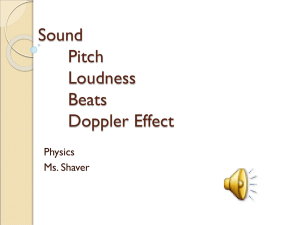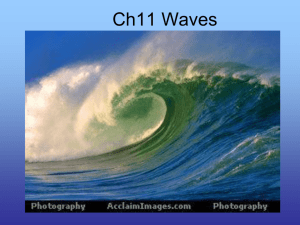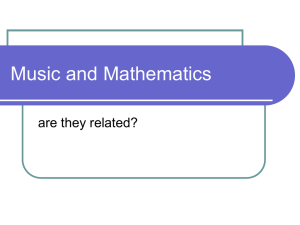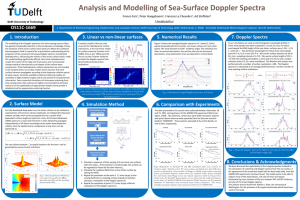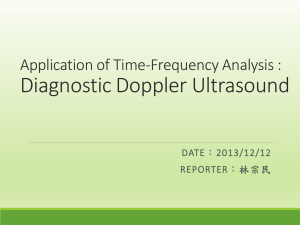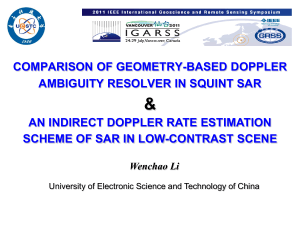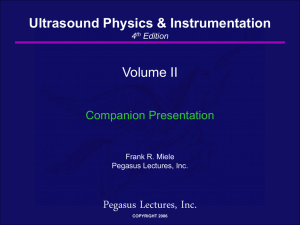File
advertisement
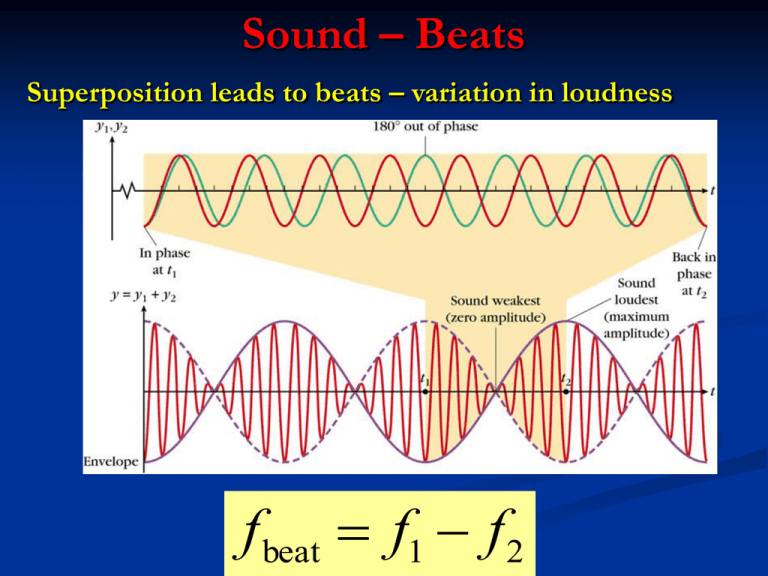
Sound – Beats Superposition leads to beats – variation in loudness f beat f1 f 2 Resonance Occurs in fixed media length L Depends on boundary conditions Occurs only for certain frequencies for which an integral number of ½ or ¼ wavelengths fit in medium length L Affected by propagation speed in medium Boundary Conditions Ends of medium are either a node or antinode Determined by the configuration of the system Stringed instruments → both ends are nodes Woodwinds, brass, organs → one end is always an antinode, the other end can be either Procedure 1. 2. Identify physical situation (string or air column) Identify boundary conditions (nodes or antinodes) a. b. 3. 4. 5. 6. If the same use ½ wavelengths If different use ¼ wavelengths Sketch waveforms → determine how many ½ or ¼ λ fit in length L For each allowed n, solve for λn Determine propagation speed v Use v = f λ to find fn Harmonic Series of Standing Waves on a Vibrating String 2. 3. 4. 5. 6. Both ends are nodes (N) – use ½ λ s Sketch Solve for λn If v not known use Solve for fn 1 L n n 2 2L n n v T lin v nv fn n 2 L Harmonic Series of a Pipe Open at Both Ends 2. 3. 4. 5. 6. Both ends are antinodes (A) – use ½ wavelengths Sketch Solve for λn If v not known use Solve for fn 1 L n n 2 2L n n T v 331 m/s 273K v nv fn n 2 L Harmonic Series of a Pipe Open at One End 2. 3. 4. 5. 6. One end A, other end N – use ¼ wavelengths Sketch Solve for λn If v not known use Solve for fn 1 L n n n odd 4 4L n n odd n T v 331 m/s 273K v nv fn n odd n 4 L Harmonics for Same Ends Note that when ends are both nodes or both antinodes, n = 1, 2, 3, 4, … f2 = 2f1 → 2nd harmonic or 1st overtone f3 = 3f1 → 3rd harmonic or 2nd overtone f4 = 4f1 → 4th harmonic or 3rd overtone f5 = 5f1 → 5th harmonic or 4th overtone And so on … fn = nf1 Harmonics for Different Ends Note that when one end is N and the other is A, n = 1, 3, 5, 7, … f3 = 3f1 → 3rd harmonic or 2nd overtone f5 = 5f1 → 5th harmonic or 4th overtone f7 = 7f1 → 7th harmonic or 6th overtone f9 = 9f1 → 9th harmonic or 8th overtone And so on … fn = nf1 → only odd harmonics are allowed Propagation Speed In a string v depends on the tension T and linear mass density μlin In an air column v depends on temperature T T (N) v (m/s) lin (kg/m) T (K) v (m/s) 331 273K Sound Levels Decibel or dB scale I sound level 10dB log10 I0 12 2 I 0 110 W/m • I0 is the threshold of hearing • Threshold of pain is 120 dB The Doppler Effect An observer of the wave crests behind or away from the direction of motion would identify a lower frequency due to a greater travel distance from the vibration source. This apparent change in frequency is called the DOPPLER EFFECT after Christian Doppler (1803 – 1853) The greater the speed, the greater the Doppler effect The police and weather reporters use the Doppler effect of radar waves to measure the speeds of cars or water in clouds. The Doppler Effect Vibrating in a stationary position produces waves in concentric circles. (because the wave speed is the same in all directions) Vibrating while moving at a speed less than the wave speed produces nonconcentric circles. The wave crests in the direction of motion occur more often (have a higher frequency) due to a shorter travel distance. Doppler Effect If source (s) is moving, detected frequency (fd) changes If detector (d) is moving, detected frequency changes v ± vd fd fs v vs • Top sign when moving away from • Bottom sign when moving towards Astronomy and the Doppler Shift Astronomers can measure the Doppler Shift of a moving object. The radio wave has a known frequency for stationary objects. If target is moving away, waves in the signal will be stretched, and will have a lower frequency. The Doppler shift is called “Red shift” if v > 0 (moving away) since the wavelength is getting longer and the frequency shorter “Blue Shift” if v < 0 (moving closer) since the wavelength is getting shorter and the frequency higher (recall that blue light is higher in frequency than red) TWO CLIPS ON THE DOPPLER EFFECT Bow Waves When the vibration source is moving at the same speed as the wave front, a bow wave is produced. In aircraft this is called the “sound barrier”. It is not a real barrier, but is where the wave crests build up on each other at the speed of sound. Speedboats and supersonic aircraft travel in front of their bow waves. Shock Waves Shock waves produced by supersonic aircraft are the 3dimensional version of the V-shaped bow wave produced by boats. On the ground this is noted as a sonic boom. BOOM ! SIMULATIONS FOR DOPPLER EFFECT AND BOW WAVES http://www.astro.ubc.ca/~scharein/a311 /Sim/doppler/Doppler.html



